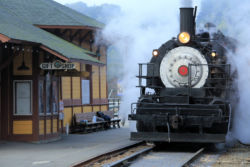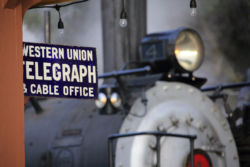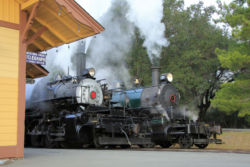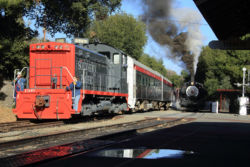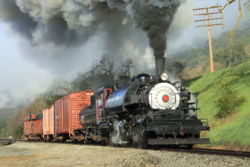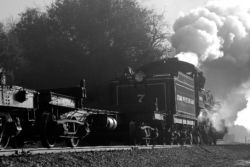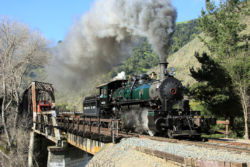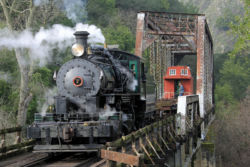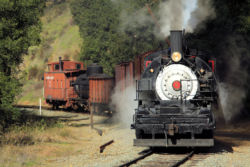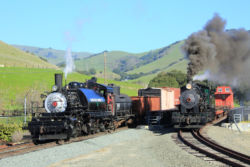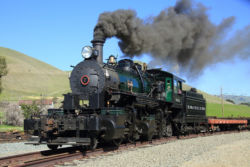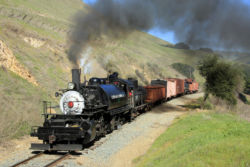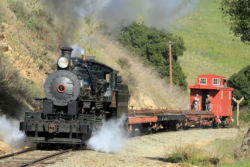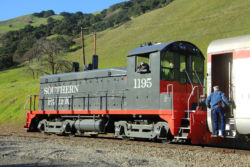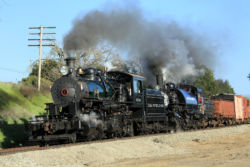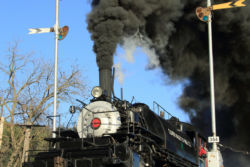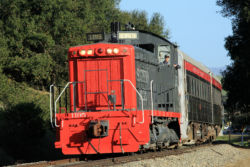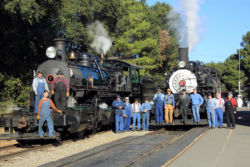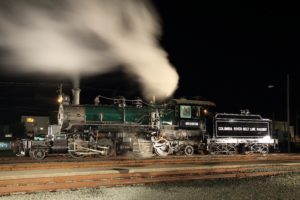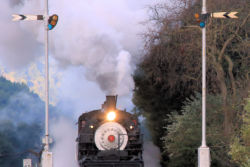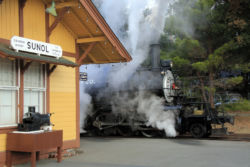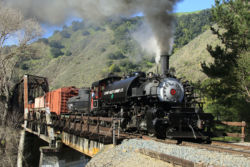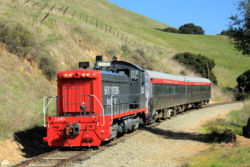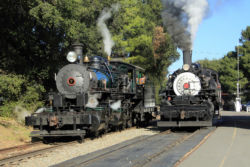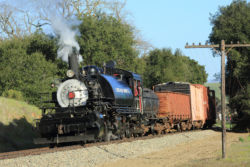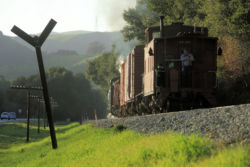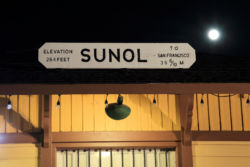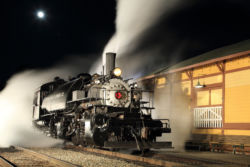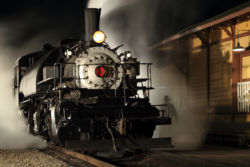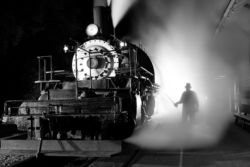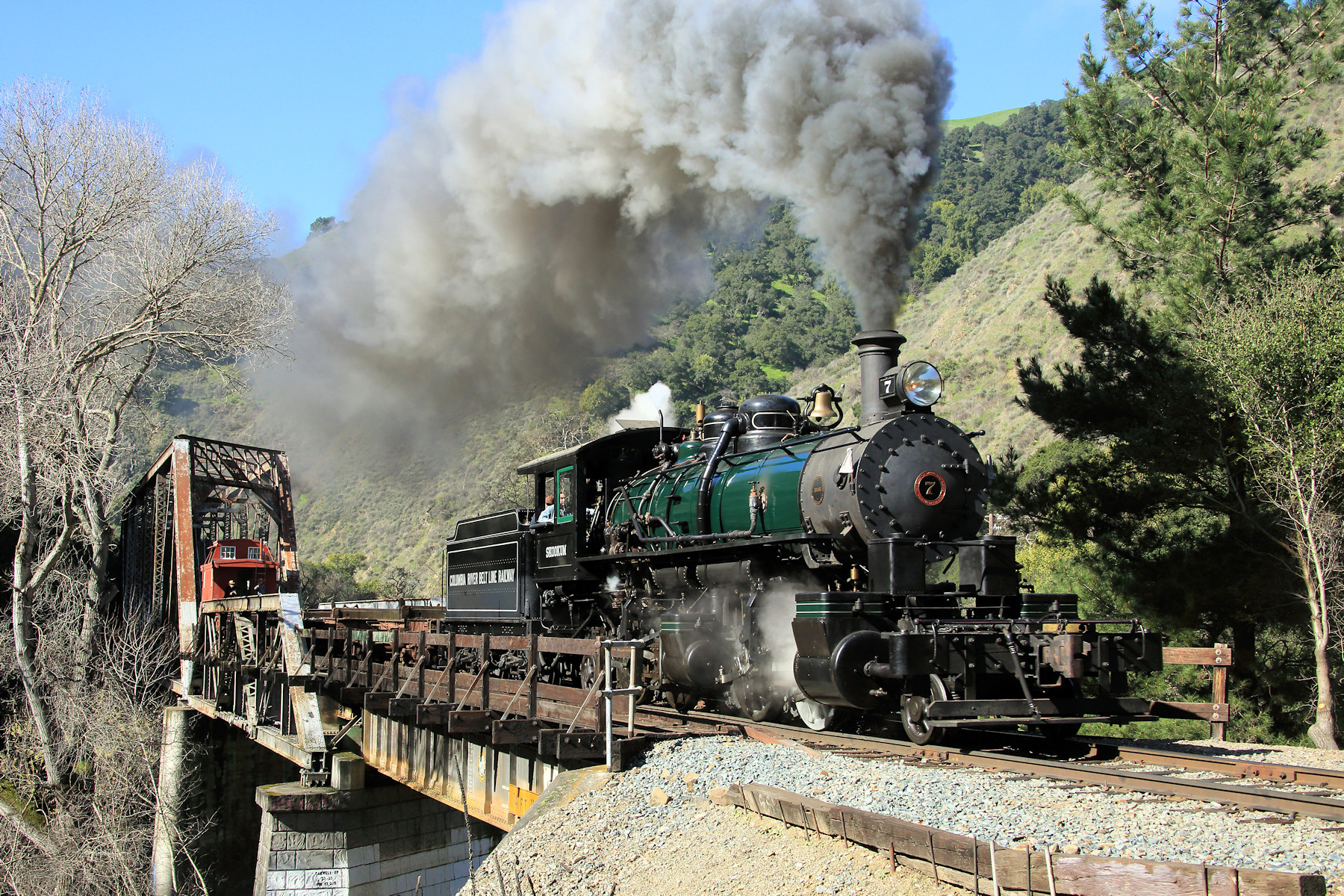
On Feb 8, 2020, Lerro Productions put together a photo charter on the Niles Canyon Railway with a pair of logging Mallets and some of the railroad’s vintage freight cars. This was a quick out-and-back for me, due to work commitments – fly out to San Jose on Friday, have the charter on Saturday, and fly back Sunday afternoon. Before we get to the photos from the day, though, it only seems fit to cover the history of these machines and why I’d fly so far for a single day.
Some Quick History Lessons
Skookum – The First Logging Mallet
Skookum is the only surviving 2-4-4-2 in North America, and one of only two known worldwide (the other is in New Zealand). It was an extremely unusual wheel arrangement, probably for good reason. More driving wheels means more contact area with the rail head, and more contact area means more tractive effort before things start slipping and sliding.
The locomotive was originally built in 1909 as #126 for the Little River Railroad – a logging line in Tennessee. Like many logging lines, the LRR was lightly constructed, with bad track, steep grades and sharp curves. The railroad wanted a locomotive powerful enough to pull long cuts of log cars efficiently, but light and flexible enough that it would handle the light trackwork.
Baldwin Locomotive Works’ answer to the Little River’s problem was a 2-4-4-2 Mallet-type locomotive. Mallets had been used in Europe since the late 1880s, typically designed to be large, powerful locomotives with high tractive effort. This idea had carried across the pond as well – the first American Mallets were a way for locomotive manufacturers to increase the driver count and continue to push power output beyond what could be achieved by standard rigid-frame designs.
Baldwin’s idea of creating a purpose-built logging Mallet was a bit of a different take on this. Rather than an effort to get as many drivers as possible, the idea was to split the driving wheels into two groups, moving independently of each other. This cut the rigid wheelbase by more than in half. This allowed for a larger locomotive than would have normally been able to negotiate the sharp logging line curves. This particular 2-4-4-2 would have a maximum rigid frame length of only 5’4″ on 48″ drivers, and weighed in at only 243,000 pounds with tender. It was, by all measures of modern locomotive in 1909, tiny and unique.
It also didn’t work. The concept was right, but the implementation was off. #126 was still too heavy for the Little River, and wound up off the rails regularly. So after only about a month of service, back to Baldwin it went, in exchange for an even smaller 2-4-4-2. Little River #148 was 10 tons lighter than #126, and had a 5′ wheelbase with 44″ drivers. These small changes were just enough, though. 148 became an instant hit, and ran until the LRR was scrapped in 1940.
This left Baldwin with a near purpose-built Mallet that needed a new buyer. One was quickly located in the Whitney Company and their Columbia River Belt Line in Blind Slough, OR. The locomotive apparently worked satisfactorily, as they kept it until selling the Blind Slough operation in 1919. Apparently Whitney was known for naming their locomotives rather than giving them traditional numbers. This one was given the moniker Skookum, which comes from a Chinook Jargon language word that translates as “strong”.
From the Columbia River Belt Line, it went to the Carlisle-Pennell Lumber Company in Onalaska, WA, in 1920, where it was given the number 7. It remained there until 1933, except for a brief and unsuccessful trial lease to the Mud Bay Lumber Company on the Olympic Peninsula. With Carlisle running out of timber, #7 was sold to the Deep River Logging Company of Deep River, WA. There she continued on for two decades as their #7.
On Feb 23, 1955, DRL #7 was returning from Naselle to Deep River when it derailed on a low trestle. At such a low speed, the engine quickly came to a rest with the tender derailed and the engine leaning to the fireman’s side. The crew felt the engine was stable enough to leave, but rerailing it would have to wait until morning when they could return with the road’s other locomotive. Before departing, the crew fired up the injectors to get a little more water in the boiler. This apparently changed the center of gravity just enough, and the engine slowly rolled off the trestle and into the marshland.
With Deep River running out of timber and the railroad nearing the end of its life, the road just wrote off the derailed engine for insurance money and rebuilt the track around it. Only a few short months later – in September 1955 – the railroad hauled its last load. By 1956, the railroad was done, and the scrappers pulled up and cut up anything of value. #7, however, was left derailed in the swamp, as Deep River Logging no longer owned it – the insurers did.
Around the same time, Seattle railfan Charles Morrow approached the insurers and purchased the derailed locomotive as-is, where-is for $1200. After working with others to establish the Puget Sound Railway Historical Association and getting storage property in Snoqualmie, Morrow and many other volunteers started dismantling #7 using only small tools and a light boom truck. The parts eventually mostly made it to Snoqualmie, but continued to sit there in piles until Morrow passed away in 1978. The remains were sold by the estate to Rogan Coombs in 1980. Nothing moved until 1991, when Coombs negotiated with the Mount Rainier Scenic Railroad to have the locomotive moved to their Mineral, WA, shops. Again, #7/Skookum sat in pieces for 14 years.
Finally in January 2005, Skookum was sold to her current owner – Chris Baldo. Almost immediately, the engine’s restoration was contracted to Scott Wickert at the Oregon Coast Scenic Railroad in Garibaldi, OR. Parts were inventoried and moved, and a 13 year saga of rebuilding began. The trials and tribulations of this saga are too long and detailed for this, but for those interested, Roots of Motive Power has published an anthology of newsletters related to Skookum called, “The Resurrection of a Locomotive: The Skookum Project”.
My first exposure to this rather unique locomotive was in 2014, on a Lerro photo charter on the Oregon Coast Scenic. At that point, Skookum was still in parts in the Garibaldi enginehouse, but was starting to come together. I’ve always been fascinated by articulated steam locomotives, and such a unique little engine was just irresistible. At that point, I decided I just had to see this engine operate.
Skookum’s first signs of life were in October 2018, when the locomotive was completely back together and under steam. Unfortunately, things with the timing weren’t quite right, and the engine took no more than a quick run around the Garibaldi yard. I got a few photos of it moving a few feet, but the “out on the road shots” couldn’t happen. Another five months went by, and the engine saw limited service on a Trains Magazine photo trip in March 2019. Unfortunately, work commitments prevented me from attending that charter, so I’d have to catch it later. Then the announcement came: as soon as the Trains charters were over, Skookum would leave her home in the Pacific Northwest and be moved to Niles Canyon for continued tuning and operation.
The Other Mallet – Clover Valley Lumber 2-6-6-2 #4
Clover Valley Lumber 2-6-6-2 #4 was built by Baldwin in 1924, and as such is the second oldest surviving Baldwin logging Mallet – second only to Skookum. It later became Feather River Lumber #4 in 1956, and then was used as a stationary boiler for the Tahoe Timber Company until the 1960s. In 1974, it was purchased by the Pacific Locomotive Association for preservation. Once restored, it operated on their Castro Point Railway until the PLA moved most of their equipment to Niles Canyon in 1986. #4 remained in storage until 2005, and was fully restored to operation in 2012.
Railways through Niles Canyon
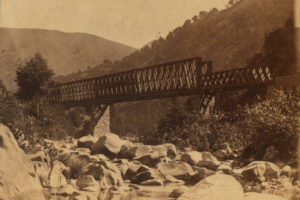
Let us not forget the original title of the Pacific Railroad Act of 1862 – the establishing legislation for the Transcontinental Railroad: “An Act to aid in the construction of a railroad and telegraph line from the Missouri river to the Pacific ocean…”
The Central Pacific that we’re all familiar with from our history books started from the banks of the Sacramento River in Sacramento, CA. From Sacramento all the way down to the Pacific were navigable waters, but Sacramento is hardly on the Pacific Ocean. Niles Canyon historians will tell you that it was that line, deep in Niles Canyon (then known as Alameda Canyon), where the real transcontinental link was finished on 6 Sep 1869. The Western Pacific (the original 1862-1870, not the one we all know) started constructing the line from San Jose through the canyon in 1862, and in 1864 partnered with the Central Pacific to construct the final western link all the way to Sacramento. This WP was merged into CP in 1870, shortly after the route was completed.
A Coloradoan Nitpicker’s Argument on this Transcontinental Stuff…
Now, I’ll take issue with all of this. The first true transcontinental link was not finished at Promontory on 10 May 1869, nor was it finished in Niles Canyon on 6 Sep 1869. The first true transcontinental link was completed in Strasburg, Colorado, on 15 Aug 1870. How can this be, you say? The Union Pacific was chartered to build from the westernmost continguous railhead in Council Bluffs, IA. However, the UP rails actually started on the western side of the Missouri River, not connecting with the eastern rail network. They did, however, build a branch south to Denver from Cheyenne in 1870, and the Kansas Pacific built a continuous line connecting Denver to the eastern roads via Kansas City’s Hannibal Bridge. Thus, the first all-rail link from the Atlantic to the Pacific actually didn’t pass through Nebraska, but rather through Kansas City, Kansas, Colorado, and Denver. The Nebraska route was not connected by steel until 27 Mar 1872, when the first Missouri River bridge opened and UP trains entered Council Bluffs directly.
Regardless of how you want to shape the Transcontinental story, the Niles route was only the preferred route into the Bay Area for ten years. By then, the Central Pacific had constructed a much shorter route via Benicia into Oakland, although it did involve a car ferries Contra Costa and Solano across the Carquinez Strait. In 1928, the car ferries were replaced with the Southern Pacific’s Benicia-Martinez bridge. The Niles Canyon route slowly faded in importance, and in 1984 SP abandoned the route and pulled up the rails. The right of way was deeded to the Alameda County.
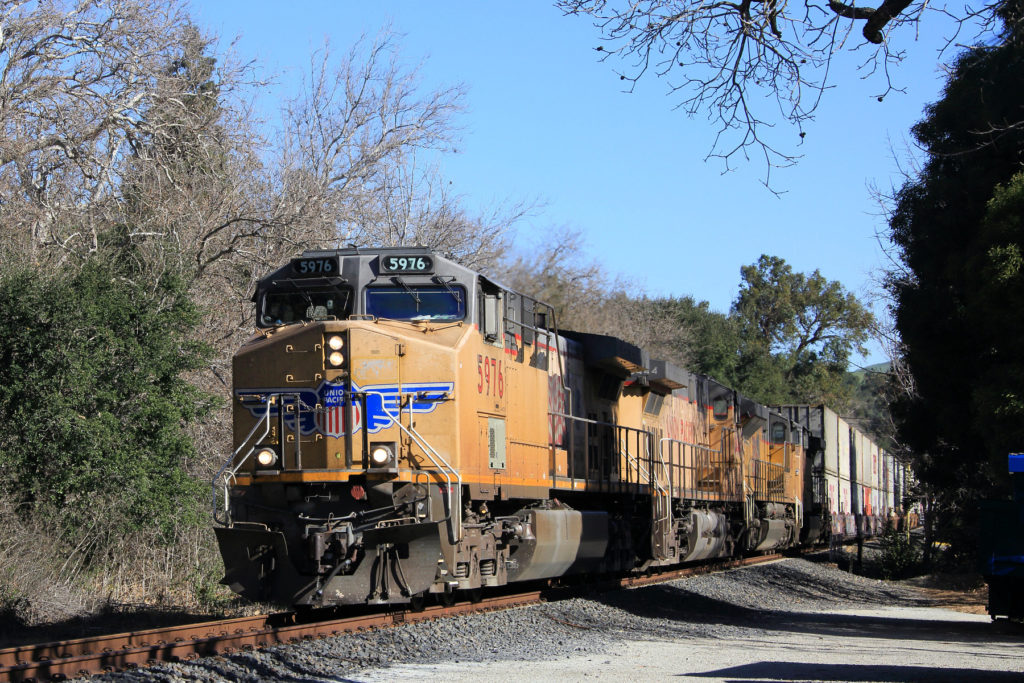
On the south side of the canyon, the Western Pacific (the one most of us know) built their mainline through in 1910. This route was significantly straighter, because the WP was forced to tunnel through several of the significant hills rather than making sharp turns. This actually made for a better route in the long run, as the line is significantly straighter and faster than the original CP / SP route. When Western Pacific merged into Union Pacific in 1982, UP kept the route as their mainline to Oakland. Even with the eventual acquisition of the Southern Pacific system and all its associated routes around the Bay Area, the line continues to operate as a heavy mainline today.
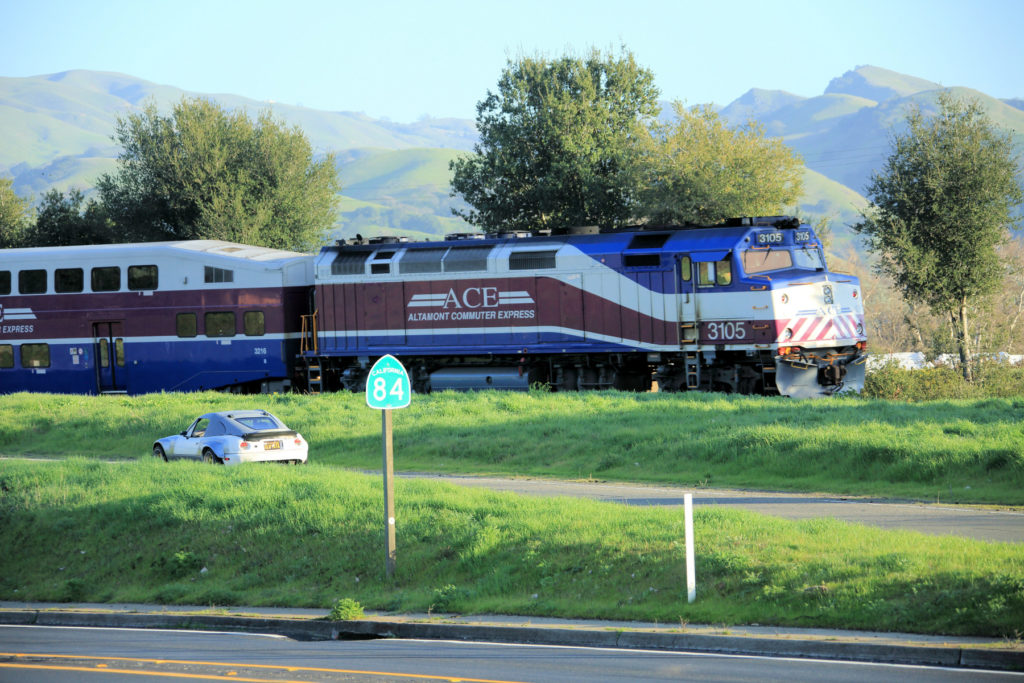
Union Pacific is not the only user of the former Western Pacific, however. In 1998, the Altamont Commuter Express service started between San Jose and Stockton as a way to move commuters into the Silicon Valley area without causing further congestion on I-580 and I-680. Originally launched with just two train sets, the service runs westbound from Stockton to San Jose in the morning and the reverse in the afternoon. There are no eastbounds in the morning, and no westbounds in the afternoon. In 2012, the service was rebranded the Altamont Corridor Express, though the timetable is still heavily focused around commuters. Currently, four trains run each way every weekday, and as of September 2019, two trains were added on Saturdays.
Today’s Niles Canyon Railway
The Pacific Locomotive Association entered into an agreement with Alameda County to lease the old right of way and open a heritage railway in 1987, and volunteers almost immediately began reconstructing the grade. The first train of the newly rebuilt Niles Canyon Railway ran from the eastern terminal of Sunol in 1988, and service was restored all the way to the western terminal of Niles in 2006. In 2010, the line was designated the Niles Canyon Transcontinental Railroad Historic District. Now the Niles Canyon volunteers are working to push rails eastward, with the goal of eventually connecting all the way into Pleasanton.
The Trip – Saturday, May 8, 2020
Columbia Belt Line “Skookum” and Clover Valley Lumber #4 double-head on a westbound out of Sunol.
